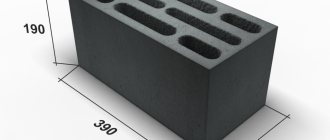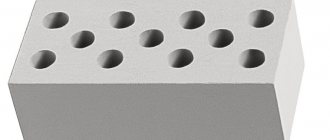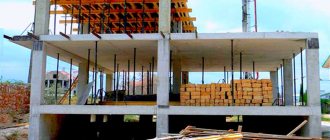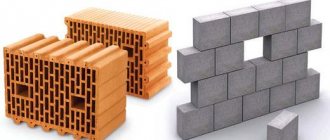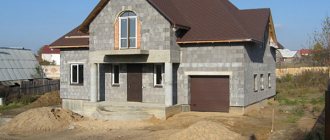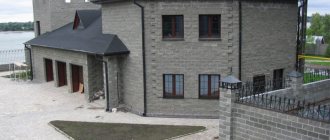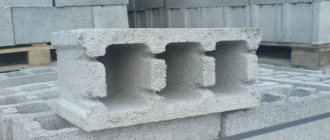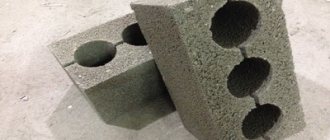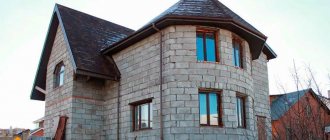Previously, sand-lime brick was called white. Now it comes in different colors: yellow, red, brown, blue. Due to its low cost and high strength, it is currently one of the most popular materials for the construction of both cottages and multi-storey buildings. A house made of silicate brick has all the properties necessary for a home: reliability, decorativeness and environmental friendliness.
Features of sand-lime brick
The basis of sand-lime brick is a mixture of sand and lime (9: 1). To ensure the shape and improve the quality of the brick (frost resistance, strength), modifiers are added. The resulting composition is pressed into molds and treated with steam (200 degrees) and pressure (8 - 12 atm).
This brick production technology is called the “autoclave synthesis method.” The dimensions and characteristics of such products are regulated by GOST 379-95.
The brand of brick is designated by the letter “M” and a number indicating the load limit during compression, after which the material collapses. Sand-lime brick has grades from M75 to M300. The taller the building, the higher the grade of brick should be.
Note! For the construction of a two-story building, sand-lime brick M100 is used.
Different types of bricks are used for internal and external walls. Depending on the purpose of the product, they are distinguished:
- Ordinary brick - there are no aesthetic requirements for the surface;
- Facing - has a smooth surface without damage, it can be white, colored, or with a relief surface.
Depending on the required strength of the walls, brick can be used:
- Solid - for load-bearing walls of low- and multi-story buildings;
- Hollow - due to reduced strength, it is used for partitions and cladding. It has good heat and sound insulation characteristics. The number of voids ranges from 3 to 14.
Note! For laying hollow bricks, the consumption of mortar increases depending on the number of air chambers. The excess can reach up to 30%.
Marking
In construction, mistakes are unacceptable, so you need to know exactly how much sand-lime brick you need per house. Labeling will help us with this. Average density, brand and frost resistance - these parameters determine the key physical properties of the brick. The cost per unit of sand-lime brick is determined by these parameters. Let's describe each of them in more detail:
- Brand (M). A parameter that can be used to determine the compressive strength of a brick. For example, for the construction of buildings with two floors, sand-lime brick of the M100 grade is used, and M175 is used for industrial buildings.
- Medium density. This parameter affects the mass of the brick and the thermal conductivity coefficient. Hollow will conduct heat better. Hollow (light) silicate bricks, which contain expanded clay sand, have a density from 1450 kg/m3 to 1650 kg/m3, and the density of solid bricks reaches 1650 kg/m3 and higher.
- Frost resistance (F). A parameter that characterizes the number of freeze-thaws. This indicator should be at least F25 if we are talking about facing bricks.
How colored sand-lime brick is made
A mixture of sand and lime produces a white-gray brick. According to the technology, such bricks are not fired, so they do not darken. To achieve a white color, bleaches and clarifiers are added to the composition when mixing.
To obtain colored sand-lime brick, chemically resistant coloring pigments are added to the main ingredients. Volumetric coloring is different in that the color on the edges and inside the product is the same. With surface painting, the thickness of the color layer is only 2-3 mm.
Three-dimensionally painted bricks are more practical, since even with chips or scratches they will retain their color. During the production process, you can obtain products of any color: from yellow-red to blue-green shades.
Bottom line
As a result, what happens is that it is possible and even necessary to use sand-lime brick in some places, but if you build entirely from it, then you are putting the quality of the house at risk and possible future repairs, but nevertheless this is possible with an accurate analysis and a special approach.
In my opinion, in order to avoid risks, it is better to use a combined option - when you use the best qualities of silicate and ordinary small-piece material. For example, use a silicate block in all internal partitions, thereby ensuring good load-bearing capacity and sound insulation, and a ceramic block along the outer perimeter, providing good wear resistance and a beautiful red brick facade. Although of course the final decision is yours...
Kinds
| Brick, photo | Characteristics |
| Single solid brick is used for laying load-bearing external and internal walls. Single hollow – for partitions and wall cladding. Dimensions, mm: 250 x 120 x 65 Solid brick weight: 3.7-4 kg Hollow brick weight: 3.2 – 3.5 kg | |
| One and a half silicate brick can also be solid or with voids. The scope of application is similar to single brick. Dimensions, mm: 250 x 120 x 88 Solid brick weight: 4.2 – 5 kg Hollow brick weight: 3.7kg | |
| Double sand-lime brick. The second name for double brick is silicate stone. Dimensions, mm: 250 x 120 x 138 Solid brick weight: 5 – 5.8 kg Hollow brick weight: 5.4 kg | |
| Sand-lime brick of standard sizes. During production, dyes are added to the mixture. Used for cladding external walls. | |
| A type of volume-painted brick - the outer edge is made with a chipped texture. The surface lined with it has the appearance of natural stone. |
Areas of application
The building material of the modification in question is widely used in private construction for the following purposes:
- Construction of permanent walls of houses, garages, utility rooms.
- External finishing of concrete, brick, aerated concrete walls.
- Creation of partitions inside finished structures.
- Formation of fences and enclosures, decorative elements.
Advice! Sand-lime brick is not used for the section of the house wall that is in direct contact with the concrete mass of the foundation, and if it is used in this case, it is only with full protection in the form of multi-layer waterproofing.
Advantages
Due to its physical properties, affordable cost and good appearance, sand-lime brick is very popular in the building materials market. The main advantages over other types of bricks are:
- Increased strength and density. All load-bearing structures of a building can be constructed from sand-lime brick. Over time, their strength increases;
- Soundproofing. Due to its high density, the material does not transmit sound well. Street noise practically does not penetrate through silicate walls. The same property is taken into account when constructing partitions;
- Vapor barrier;
- Environmental friendliness. It is made from natural materials and therefore does not have a harmful effect on humans. It is not susceptible to fungus and mold due to the presence of lime in its composition. Does not emit radiation;
- Economical. Its price is 15 - 20% less than red ceramic brick due to lower energy consumption and labor intensity during production;
- Long service life;
- Heat-resistant, non-flammable material can withstand temperatures up to 5000 without changing its characteristics;
- Highly decorative product. In addition to ordinary bricks, facing bricks are produced in a wide range of colors with a smooth and embossed surface.
The main pros and cons of the material
In conclusion, we list all the pros and cons of sand-lime brick, so that everyone can decide on the choice of this or another material for building their home.
Pros:
- strength, durability
- aesthetics, environmental friendliness
- fire resistance
- frost resistance
- good sound insulation
- not subject to rotting or destruction
- quite low cost
Minuses:
- high water absorption
- quite heavy weight
Flaws
Of course, not all characteristics of silicate are positive. But when building a house from sand-lime brick, the shortcomings can be eliminated with the help of additional measures:
- High thermal conductivity. A house made of sand-lime brick does not retain heat well due to its high density, and therefore requires insulation. The construction of walls with two-layer masonry, in which the inner layer is made of solid material and the outer layer is made of hollow material, provides the structure with both strength and sufficient thermal insulation;
- Hygroscopicity. Sand-lime brick strongly absorbs water, which limits its use in the construction of foundations, basements and rooms with high humidity. Special impregnations for walls create a protective layer on the surface;
- Heavy weight. Silicate is heavier than other types of brick. A building made from this material is strong and stable, but heavy, so a reinforced foundation is required;
- It is destroyed at temperatures above 6000, therefore it is not used for the construction of stoves and chimneys.
Difference from ceramic stone
Sand-lime brick is much superior to clay stone in terms of technical characteristics
There is no doubt about the environmental purity of sand-lime brick. In this way it is similar to its ceramic counterpart. The dimensions of both materials are also similar. However, sand-lime brick, a photo of which can be found on the Internet, is much superior to clay stone in terms of technical characteristics.
However, despite their similar sizes, silicate products are significantly inferior to their ceramic counterparts in frost resistance, fire resistance, water resistance, and chemical resistance. According to GOST, a standard silicate stone has a density of 1400-1600 kg/m³, and its thermal conductivity is 0.6-0.7 W/m°C. As a result, with regular moistening, the strength of the silicate material decreases.
General characteristics common to both silicates and ceramic products:
- Ecological cleanliness. For production, only natural raw materials are used - clay or lime, water and sand.
- High sound insulation characteristics.
- Excellent strength and frost resistance.
- Durability, unpretentiousness and reliability of the material.
The main differences between silicate and its ceramic counterpart are its low water resistance and heat resistance. That is why this material should not be used in conditions of high humidity and high temperatures. The high thermal conductivity of solid silicate stone forces thicker walls to be made, which increases the load on the foundation. The positive difference between these products and ceramic elements is that their price is lower.
Delivery and storage
Sand-lime bricks purchased from a factory are usually delivered on pallets. The bags are wrapped in protective film and secured with packing tape. It is not recommended to remove the original packaging for storage. You just need to check that there are small holes in it for ventilation. Otherwise, condensation may damage some of the products.
It is better to place the pallets under a canopy on a solid base. The best option is a concrete floor. You should prepare a site with a slight slope in advance to prevent water from accumulating. If the pallets are planned to be placed directly on the ground, boards or logs are placed under them.
Note! The storage area for pallets with sand-lime bricks must be well ventilated and have a roof to protect it from rain and snow.
Brickwork
The walls serve not only as a load-bearing structure, but also as an enclosing structure, which should retain heat in the house. In terms of strength, for a 1 - 2-story house, a wall made of sand-lime brick with a thickness of 250 mm (in brick) is sufficient. But such a wall will freeze in winter.
To reduce the thermal conductivity of the walls, external insulation is used, which after installation is plastered and painted. The finish is short-lived and requires periodic restoration.
Layered masonry creates a reliable decorative wall covering that does not require repairs for many years. Its essence is that the inner layer of the wall is made of solid brick, and the outer layer is made of hollow brick. Air chambers reduce heat loss from the building. To enhance the effect, insulation is placed between the layers: mineral wool, expanded polystyrene and others.
Multi-colored sand-lime bricks are often used for the exterior. By combining different shades of material, you can create patterns on the facade with your own hands, highlighting corners or openings with color. The textured brick finish looks very impressive. This material resembles natural stone.
Laying sand-lime bricks should be carried out according to the general rules of masonry work:
- Waterproofing is laid under the first row of bricks;
- Before starting work, the brick is moistened in a container of water so that it does not draw water out of the solution;
- The laying of the wall begins from the corners, which are laid out in 6-8 rows, after which the wall is built along the cord to their level. This cycle is repeated all the way to the top of the wall;
- Bandaging the seams is mandatory; it ensures uniform distribution of the load over the entire wall;
- The horizontality and verticality of the rows is checked by level and plumb line;
- Unlike laying ceramic bricks, a thicker solution is prepared for silicate. The ratio of cement and sand is the same (1: 3).
Main types of insulation and their brief description
Organic heat insulators on the market are represented by a wide range of products.
They are based on materials of natural origin:
- Arbolite insulation is considered the newest material, which is based on sawdust, shavings, uncut straw and reeds. Also, the insulation is made of cement and organic additives. These are CaCl2, H2SO4, as well as the product obtained after processing ordinary clay, kaolin or nepheline, and Na2O.
- Foam-polyvinyl chloride insulation. It consists of polyvinyl chloride resin, which, after exposure to light or electromagnetic vibrations, acquires a characteristic foam structure. At the same time, it is considered a universal heat insulator.
- Chipboard insulation. Components - shavings, resin obtained as a result of controlled chemical processes, antiseptics, fire retardant.
- Insulation with a fiberboard base. It resembles chipboard in its own way. The base is wood waste, or trimmed corn and straw stalks. The material may well also consist of compressed old paper.
- Polyurethane foam is based on polyester, it includes H2O, an emulsifier and isocyanates. When catalysts begin to act, all elements interact as a result of a chemical reaction, in which a new type of insulation appears.
Inorganic heat insulators
Mineral wool comes in two types: slag and stone. To produce the first, companies use slag. Stone wool is distinguished by: CaCO3, rocks that are used for paving streets, minerals containing calcium and magnesia, volcanic rocks and others.
Wall care
Considering the property of silicate to intensively absorb moisture from the atmosphere, not to mention the direct contact of precipitation on the walls, bricks are protected using impregnations. Compositions that give water-repellent properties to bricks are called water repellents.
When treating a wall, the water repellent penetrates into the surface layer of the material to a depth of 10 mm and protects it from moisture. In this case, as the instructions indicate, a film is not formed that closes the pores and the vapor permeability of the structure does not decrease. Impregnations prevent the appearance of efflorescence.
Coating walls with protective compounds increases the service life of bricks and preserves its visual appeal. The type of impregnation depends on the component on which the composition is prepared. They are:
- Acrylic;
- Silicone;
- Varnish – impregnation (gives the brick a gloss);
- Water-repellent liquids.
Houses made of silicate brick, like those made of other materials, are subject to contamination. Especially on light-colored walls, a dirty coating is visible. Special impregnations limit the accumulation of dust and, if necessary, make cleaning the surface easier.
Another method of protective finishing is plastering. The specificity of the technology is determined by the properties of sand-lime brick. These include the intensity of water absorption and the smoothness of the texture, which lead to:
- Increased labor intensity;
- High consumption of plaster mortar;
- Mandatory use of plaster mesh.
Otherwise, plastering work does not differ from the standard technique. To finish the plastered surface, painting with compositions for external use is used.
Who will build
You can build a brick house with your own hands, without resorting to the services of professional builders - this will save a significant amount of money. But you need to be aware that laying brick is not an easy task. This is why specialists charge quite expensive fees for their work. When you decide to build a house yourself, you must understand how many risks you are taking on. You can read more about this in our special article.
There are a number of requirements for the quality of brickwork and compliance with established standards. It is important to take into account the whole range of factors, such as the brand of brick and mortar, the need to moisten the blocks before laying, the correctness of the seams and dressings, the exact level of surfaces and corners of the brick, and many other nuances.
Remember that the durability and strength of the structure being constructed depends on the correct fulfillment of the conditions. An inexperienced person can overestimate his own strengths and make critical mistakes. Ultimately, this may not lead to savings, but, on the contrary, to an increase in costs due to the correction of ineptly performed work and the purchase of new material.
Building a house is a costly process in all respects; when starting construction, you need to be prepared for significant expenses. But a house is built to last for more than one year - it will serve you, and then remain for the next several generations of the family. Therefore, experts strongly do not recommend saving on professional designers and builders - choosing qualified and responsible contractors will ensure trouble-free operation of your home for many years.
Choosing the right people who will build your house is a separate serious topic. Previously, we have already examined in detail all the key factors that you need to focus on when choosing a construction company or team. First of all, you need to choose a reputable, reputable company that has sufficient experience in the construction market and real positive reviews of its work. Carefully study the website and portfolio of completed projects. Carefully analyze the construction estimate - you should be wary of promises to build a house too quickly or too low a price for services.
To build walls for a brick house with an area of 250 square meters. m. will take about 1.5-2 months, depending on the number of floors of the house, the complexity of the project and the thickness of the walls. As for the cost of building a brick house, this value is very variable. It depends not only on the architectural design and brand of brick, but also on the geographic location of construction. To find out the objective cost of building a brick house in your region, we recommend ordering an estimate from several construction companies and comparing the proposals received.
